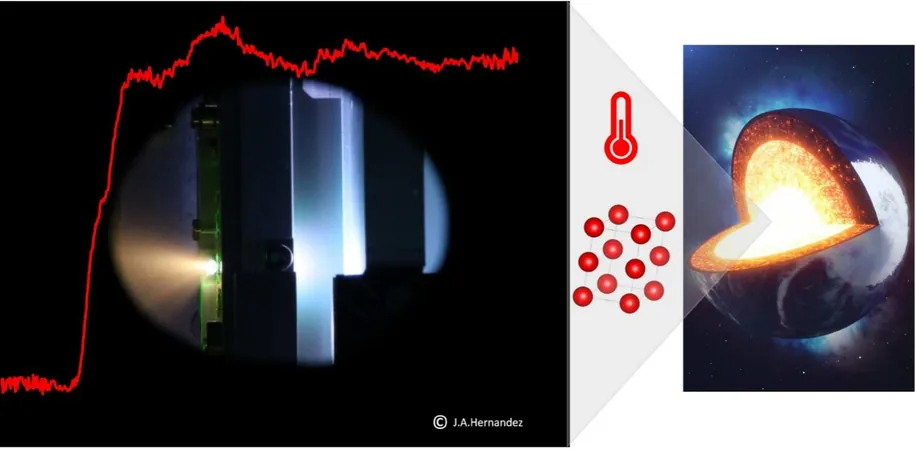
New Insights into Iron's Behavior Under Extreme Conditions Could Transform Our Understanding of Earth’s Geodynamics
2025-01-21
Author: Wei Ling
Introduction
Iron, a fundamental component of the Earth's inner core, is subjected to unprecedented temperatures and pressures that can reach thousands of degrees Kelvin and multi-megabar levels. Recent research conducted by scientists at the European Synchrotron Radiation Facility in Grenoble, the Polytechnic Institute of Paris, and other international research centers has transformed our understanding of how iron behaves under these extreme conditions.
Groundbreaking Study
Published in Physical Review Letters, this groundbreaking study employs ultrafast X-ray absorption spectroscopy to investigate the melting temperature and phase stability of shock-compressed iron. "Our aim was to delve deep into the microscopic behavior of iron at extreme pressures and temperatures which mimic those at the Earth's core," explains Sofia Balugani, the leading author of the study.
Importance of Understanding Iron's Properties
Understanding the properties of iron in such conditions is crucial. As the primary constituent of the Earth's core, its characteristics inform scientists about the melting temperature near the boundary between the solid inner core and the liquid outer core. This knowledge is instrumental in understanding geodynamic processes, especially concerning how the outer core crystallizes to form the inner core.
Research Findings
However, heated debates linger about the structural phase of iron under these conditions. The research team investigated both the structural and electronic properties of iron to provide clarity. "By determining the structural changes that occur in iron under extreme conditions, we hope to better interpret the nature of the Earth's core," says Balugani. The experiments were conducted in the High-Power Laser Facility at the European Synchrotron, utilizing advanced technologies that integrate powerful lasers with X-ray absorption techniques.
Pivotal Discovery
Interestingly, the research revealed that at 240 GPa and a staggering 5,345 K—just shy of melting—I was found to exhibit a hexagonal close-packed (hcp) structure, which contradicts previous predictions of a body-centered cubic (bcc) structure. "This finding is pivotal," Balugani notes, "as it challenges long-held assumptions and sets new constraints on the melting curve of iron under extreme conditions."
Broader Implications
The implications of their findings extend far beyond academic curiosity. By refining the understanding of melting temperatures and structural phases, the research could shift paradigms in geophysical studies. Moreover, the methodology developed could also aid in studying the complex behaviors of iron alloys, significantly impacting our knowledge of planetary structures, including exoplanets classified as super-Earths.
Future Directions
Future experiments could lead to exciting discoveries not just for Earth science, but also in the field of nuclear fusion research, where iron's properties play a crucial role in the materials used for inertial confinement fusion.
Conclusion
As advances in technology persist, scientists like Balugani are eager to explore even more extreme environments within the iron phase diagram—a frontier that could reshape our comprehension of planetary science and nuclear physics alike. This thrilling research could soon unlock answers to some of the most persisting questions surrounding the composition and behavior of materials deep within our planet and beyond!


 Brasil (PT)
Brasil (PT)
 Canada (EN)
Canada (EN)
 Chile (ES)
Chile (ES)
 Česko (CS)
Česko (CS)
 대한민국 (KO)
대한민국 (KO)
 España (ES)
España (ES)
 France (FR)
France (FR)
 Hong Kong (EN)
Hong Kong (EN)
 Italia (IT)
Italia (IT)
 日本 (JA)
日本 (JA)
 Magyarország (HU)
Magyarország (HU)
 Norge (NO)
Norge (NO)
 Polska (PL)
Polska (PL)
 Schweiz (DE)
Schweiz (DE)
 Singapore (EN)
Singapore (EN)
 Sverige (SV)
Sverige (SV)
 Suomi (FI)
Suomi (FI)
 Türkiye (TR)
Türkiye (TR)
 الإمارات العربية المتحدة (AR)
الإمارات العربية المتحدة (AR)